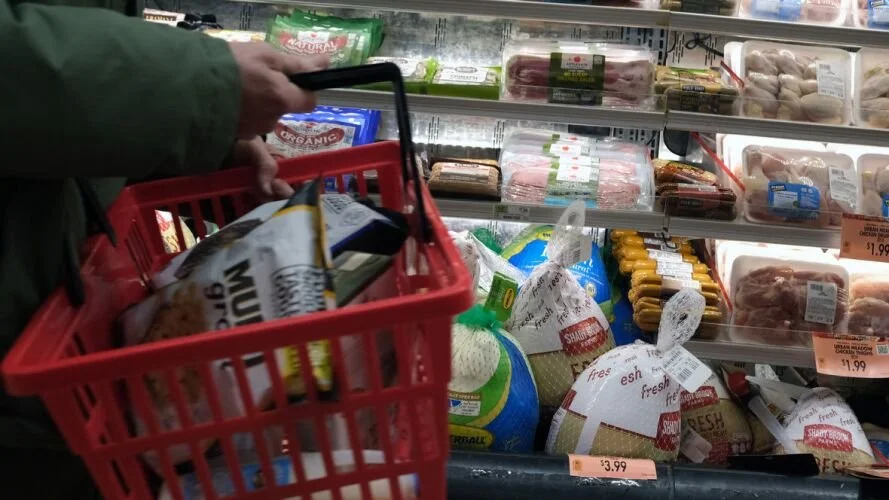Federal actions hit hardest on needy families in small cities and rural, southwest counties, according to a VCIJ at WHRO analysis
By Kunle Falayi
Virginia Center for Investigative Journalism at WHRO
Federal cancellations of food bank contracts and stalled assistance for needy families will hit hardest in Virginia's rural and urban communities, according to an analysis by the Virginia Center for Investigative Journalism at WHRO.
About one in three residents in Petersburg, Franklin, Danville, and Hopewell depend on the Supplemental Nutrition Assistance Program (SNAP). Southwest Virginia communities have the highest rates of SNAP usage of any region in the state, according to the VCIJ at WHRO analysis.
The delays in SNAP benefits, coupled with cuts to federal aid and the economic struggles of rural communities, could have far-reaching implications, said Virginia Tech professor Elena Serrano. Federal nutrition assistance programs like SNAP are critical to the survival of many people, she said.
“SNAP was designed to supplement a household or person's food budget,” said Serrano, who researches the effectiveness of food and nutrition programs. “But for many households and individuals, it is the sole source of food dollars that they use to purchase food.”
On November 3, Gov. Glenn Youngkin launched a $1 million emergency food assistance program in response to the federal government shutdown, which has delayed funding for SNAP.
The swift intervention underscores the critical role SNAP has played in feeding families across the Commonwealth. It also highlights how many Virginians still deal with food insecurity across the state.
About 10% of Virginia’s population receives SNAP benefits, below the national average of over 12%. Virginia’s rate has remained largely stable, excluding the shutdowns during the COVID pandemic.
In 2024, over 41 million Americans received SNAP benefits, according to the U.S. Department of Agriculture data. Democratic lawmakers have expressed concern that proposed cuts by the Trump administration could jeopardize access to what many families consider their primary source of food assistance. Shortly after President Donald Trump took office, DOGE cancelled $500 million in food bank purchases. Trump threatened to cut SNAP payments this week, a threat later walked back by the White House.
SNAP participation rates vary widely across Virginia’s counties and cities, revealing how the impact of federal cuts could be unevenly felt. In some localities, a significant portion of the population depends on SNAP, making them especially vulnerable if the Virginia Emergency Nutrition Assistance (VENA) had not been launched.
In Hampton Roads and the Eastern Shore, Portsmouth has the highest rate of participation at 23%, while more than 18% of the populations of Newport News and Northampton County use SNAP benefits. More than 16% of Norfolk residents supplement their food budget through the program, while those in Virginia Beach fare better with less than 8% participation.
In Richmond, more than 16% of residents receive SNAP benefits.
In Petersburg, where over 34% of the population uses SNAP, the city manager told VCIJ that SNAP and VENA are critical to one of the city’s most long-standing problems.
“Food insecurity remains one of Petersburg’s most persistent challenges, rooted in poverty and limited access to affordable food options,” said Petersburg City Manager March Altman. The two programs, he said, “strengthen our local economy by supporting neighborhood stores and circulating dollars within the community.”
Southwest Virginia shows the highest overall need for SNAP at 16.2% of the population compared to only 6.2% in Northern Virginia, according to VCIJ at WHRO’s analysis of data from the Virginia Department of Social Services. The analysis is based on a weighted average of county-level SNAP participation rates, which accounts for population sizes.
Southwest Virginia, with its heavy dependence on SNAP, also was targeted by the USDA for the deepest cuts to local food pantry support, according to federal data obtained by ProPublica.
Last month, ProPublica reported that the Trump administration cut $500 million in deliveries from a program that sends U.S.-produced meat, dairy, eggs and produce to food banks and other organizations across the country. Between May and August 2025 alone, the federal government cancelled nearly 1.8 million pounds of food aid to Virginia.
Professor Serrano called the combination of cuts a potential crisis for rural communities where SNAP participation is higher.
“It can be devastating,” she said. “There are fewer deliveries to food banks and food pantries. Second of all, we're just seeing declines in the economy. We have VENA, and Youngkin has earmarked $1 million to help buffer the food insecurity that we're facing across Virginia, but we are still in a crisis right now.”
In October, Youngkin announced the VENA fund would provide food benefits in seven-day increments in November.
“The Virginia Emergency Nutrition Assistance effort will be very similar to SNAP– but it is a complex, challenging solution,” the governor said in a statement. “However, we must ensure our most vulnerable Virginians are not without basic nutrition.”
Before VENA launched this week, many SNAP recipients relied on food banks and pantries as a fallback. With federal benefits stalled, those unable to access SNAP turned to these local resources in large numbers, Bob Latvis, CEO of Foodbank of the Peninsula, told VCIJ.
“We are seeing about a 25% to 30% increase in our lines – that's the amount of neighbors that we have seen in our pantries and at our partner agencies in our two largest cities, Hampton and Newport News," said Latvis, who leads one of Virginia’s seven major food banks.
The increase in turnout at food banks induced by the SNAP cuts is putting pressure on their finances. And it is not just in Hampton Roads, Serrano said.
Many donors on which food banks and pantries often depend are pulling back, she said.
“Food banks are really being crushed right now, both in terms of what they have to provide and the demand that is increasing,” she said. “What we're hearing is that they're exceeding capacity and they're extremely stressed.”
However, with VENA, Serrano believes Virginia will fare better than other states.
Reach Kunle Falayi at kunle.falayi@vcij.org.


